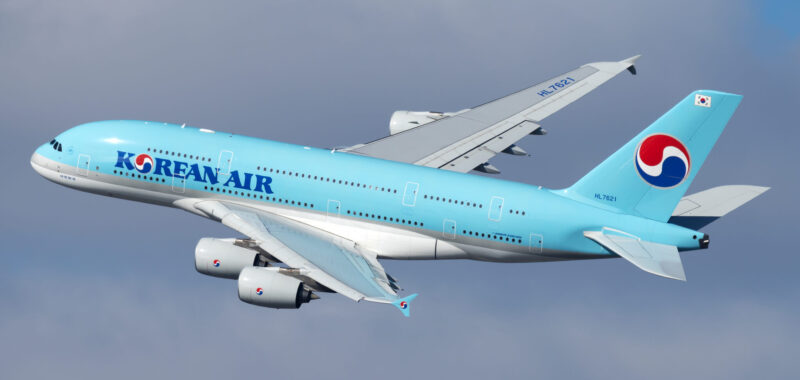All eyes are on Washington D.C. as the proposed merger of South Korea’s two largest airlines reaches its final regulatory hurdle. It follows an announcement by the European Commission late last week that the conditions it set for the deal have now been satisfied.
If – or more likely when – realized, the coming together of Korean Air and Asiana Airlines will turn two significant carriers into a formidable aviation powerhouse.
The developments in Brussels leave the United States as the last of 14 global regulators to allow the deal. In February, European competition authorities granted the proposed merger conditional clearance. In practice, this meant formal approval was dependent on certain pro-competition commitments being honored.
The first of these required Korean Air to sell Asiana Airlines’ cargo unit, which it has done. The second focused on four routes between Europe and South Korea where the two airlines had overlapping networks. With Seoul-based rival T’Way Air now operating to Barcelona, Frankfurt, Paris, and Rome, the European competition watchdog has cleared the deal.
What Happens Next?
In a statement, Korean Air said it has submitted the European Commission’s final approval to the U.S. Department of Justice and “plans to complete the transaction by December 2024.”
The company’s bullish timeline – with completion by year-end – suggests it is confident that the DOJ is looking favorably upon the deal. However, there could yet be strings attached.
The European Commission was not alone in demanding Korean Air and Asiana make concessions to promote stronger competition. For example, officials in the U.K. said Virgin Atlantic should be allowed to start a London-Seoul route as a condition of approval, while Japan requested changes be made on relevant routes to and from South Korea. It remains possible that regulators in Washington could follow a similar path.
What’s the History of the Proposed Deal?
In November 2020, at the peak of the Covid-19 crisis, Korean Air said it wanted to acquire a controlling stake in Asiana. At the time, the $1.6 billion deal was framed not only as a response to the challenges of the pandemic but also as a solution to systemic issues in South Korea’s aviation industry.
The formal application process to global regulators started in January 2021. Türkiye was the first to approve the merger, followed by Taiwan, Thailand, The Philippines, Malaysia, and Vietnam later that year.
Nods from South Korea, Singapore, Australia, and China came in 2022, while the U.K. said yes last year. Japan followed suit in January 2024, leaving the European Union and the U.S. as the final obstacles.
Airline mergers and acquisitions are rarely straightforward, however even by industry standards, the Korean tie-up has been prolonged.
The combined business would create the 10th largest airline globally by fleet size. The more dominant Korean Air brand would remain and Asiana’s corporate identity would be phased out as the merger concludes. It is also expected that various low-cost subsidiaries operated by the two companies will be streamlined under the Jin Air brand.
How Could It Impact U.S. Travelers?
Any deal will bring big changes for passengers. Korean Air is a founding member of SkyTeam, while Asiana belongs to rival Star Alliance. A merger will see Asiana’s assets absorbed into Korean Air and Asiana surrender its current alliance membership. This would leave Star Alliance members – including, but not limited to United Airlines – in a weaker position due to reduced connectivity options.
Conversely, it would further strengthen Delta Air Lines’ position on transpacific routes. In 2018, Korean Air and Delta signed a powerful joint venture agreement that reaches far beyond regular SkyTeam partnership terms.
Fueled by the operating synergies, Skift analysis of Cirium Diio data shows the two airlines operate an average of 19 flights a day between Seoul’s Incheon Airport and the United States. Asiana operates a further five or six, including an ultra long-haul route between Seoul and New York. It remains to be seen how many of these overlapping frequencies will be retained in the post-merger business.
Among the other major U.S. carriers, United flies to South Korea just twice a day – both services from its San Francisco hub – while American Airlines operates a single daily link from Dallas Fort-Worth to Seoul. Niche Korean player Air Premia is the only other scheduled operator between Seoul and the contiguous United States.
Seoul’s modern international airport and strategic location in East Asia have long made it a popular connection point for travelers. More recent developments, including the weakening of air connectivity between the United States and China, have generated further demand for travel to, from, and via the country.
Airlines Sector Stock Index Performance Year-to-Date
What am I looking at? The performance of airline sector stocks within the ST200. The index includes companies publicly traded across global markets including network carriers, low-cost carriers, and other related companies.
The Skift Travel 200 (ST200) combines the financial performance of nearly 200 travel companies worth more than a trillion dollars into a single number. See more airlines sector financial performance.
Read the full methodology behind the Skift Travel 200.

